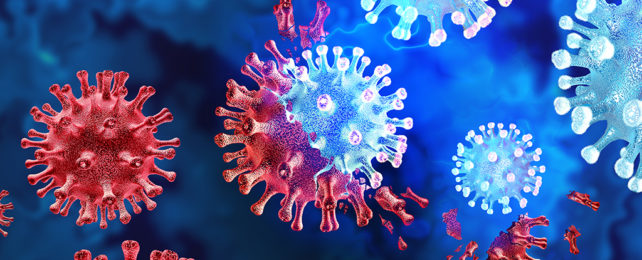A type of freshwater plankton has become the first organism seen thriving on a diet of viruses, according to a new study by researchers from the University of Nebraska-Lincoln in the US.
Viruses are often consumed incidentally by a wide range of organisms, and may even season the diets of certain marine protists. But to qualify as a true step in the food chain – described as virovory – viruses ought to contribute a significant amount of energy or nutrients to their consumer.
The microbe Halteria is a common genus of protist known to flit about as its hair-like cilia propel it through the water. Not only did laboratory samples of the ciliate consume chloroviruses added to its environment, the giant virus fueled Halteria's growth and increased its population size.
The knock-on effects of widespread consumption of chloroviruses in the wild could have a profound impact on the carbon cycle. Known to infect microscopic green algae, chloroviruses cause their hosts to burst apart, releasing carbon and other nutrients into the environment – a process that serious amounts of virus-eating could be limiting.
"If you multiply a crude estimate of how many viruses there are, how many ciliates there are and how much water there is, it comes out to this massive amount of energy movement up the food chain," says ecologist John DeLong, from the University of Nebraska-Lincoln.
"If this is happening at the scale that we think it could be, it should completely change our view on global carbon cycling."
The research has been three years in the making, and was based on the idea that the sheer number of viruses and microorganisms that can be found in water may well lead to the former being eaten by the latter – though there weren't many previous studies that the scientists could turn to for reference.
There's some good stuff inside viruses if you're an organism looking to feed, including amino acids, nucleic acids, lipids, nitrogen, and phosphorus. Surely something would want to make a meal out of that, the researchers reasoned.
The team collected pond water samples and added chloroviruses to them, looking to see if any species treated the viruses as food rather than a threat. That led them to Halteria and Paramecium, both of which were thriving in the water.
While the Paramecium snacked on the viruses, its sizes and numbers barely budged. Halteria, on the other hand, dined on them, using the chlorovirus as a source of nutrients. The ciliate's population grew about 15 times larger in two days, while the virus population dropped a hundredfold.
"At first, it was just a suggestion that there were more of [the Halteria organisms]," says DeLong. "But then they were big enough that I could actually grab some with a pipette tip, put them in a clean drop, and be able to count them."
Fluorescent green dye was used to tag chlorovirus DNA before it was introduced to the two types of plankton. This confirmed that the viruses were being eaten: the vacuoles – microbial equivalent of stomachs – were glowing green from the feeding.
Further analysis revealed that the growth of Halteria in comparison to the decline of the chlorovirus matched the ratios seen in other microscopic predator vs prey relationships in aquatic environments, giving the team more evidence of what was happening.
There's still a lot more to explore here. Next, the researchers want to look at how virovores might affect the food web, and the evolution of species, and the resilience of populations. Before that though, they need to gather evidence of it happening in the wild.
"I was motivated to determine whether or not this was weird, or whether it fit," says DeLong. "This is not weird. It's just that nobody noticed it."
"Now we have to go find out if this is true in nature."
The research has been published in PNAS.
